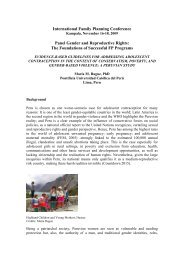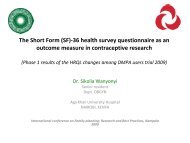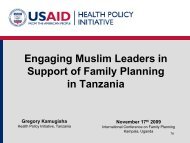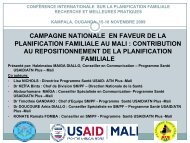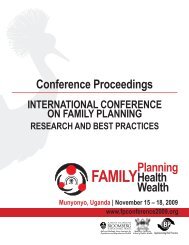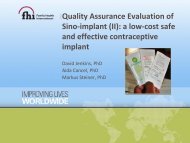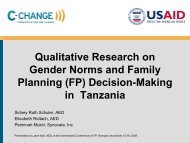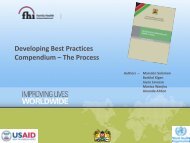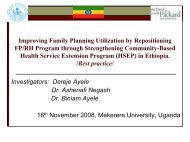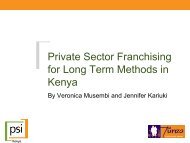A model of integration - International Conference on Family Planning
A model of integration - International Conference on Family Planning
A model of integration - International Conference on Family Planning
Create successful ePaper yourself
Turn your PDF publications into a flip-book with our unique Google optimized e-Paper software.
A <str<strong>on</strong>g>model</str<strong>on</strong>g> <str<strong>on</strong>g>of</str<strong>on</strong>g> <str<strong>on</strong>g>integrati<strong>on</strong></str<strong>on</strong>g>: Postpartum<br />
family planning through a community<br />
based maternal and newborn program<br />
Salahuddin Ahmed,1 Rasheduzzaman Shah,1 Ishtiaq Mannan,1 Angela Nash-Mercado,2<br />
Peter Winch,1 Saifuddin Ahmed,1 Emma Williams,1 Nazma Begum,3 Ahmed Al-Kabir,4<br />
Robin Anth<strong>on</strong>y Kouyate,2 Catharine McKaig,2 Maureen Nort<strong>on</strong>,5 and Abdullah Baqui1<br />
1Johns Hopkins Bloomberg School <str<strong>on</strong>g>of</str<strong>on</strong>g> Public Health; 2ACCESS-FP, Jhpiego; 3ICDDRB;<br />
4RTM <str<strong>on</strong>g>Internati<strong>on</strong>al</str<strong>on</strong>g>; 5USAID/Washingt<strong>on</strong><br />
November 16, 2009
Background: Bangladesh and Sylhet District<br />
Unmet FP need<br />
Overall<br />
C<strong>on</strong>traceptive<br />
Prevalence Rate<br />
BDHS 2007<br />
BGD Syl<br />
18% 26%<br />
56% 31%<br />
Total Fertility Rate 2.7 3.7<br />
Sources: Bangladesh DHS 2007<br />
2
Birth Intervals<br />
Birth<br />
intervals<br />
< 24<br />
m<strong>on</strong>ths<br />
< 36<br />
m<strong>on</strong>ths<br />
Sources: Bangladesh DHS 2007<br />
Bangladesh Sylhet<br />
15.1% 26.1%<br />
36.9% 56.8%<br />
3
Study sites<br />
Sylhet district<br />
Zakiganj &<br />
Kanaighat subdistrict<br />
Interventi<strong>on</strong> area:<br />
4 uni<strong>on</strong>s<br />
Comparis<strong>on</strong> area :<br />
4 uni<strong>on</strong>s<br />
4
Study objectives<br />
To develop and test an integrated <strong>Family</strong><br />
<strong>Planning</strong>, Maternal and Ne<strong>on</strong>atal Health<br />
(FP/MNH) service delivery approach.<br />
To assess:<br />
the strengths and limitati<strong>on</strong>s <str<strong>on</strong>g>of</str<strong>on</strong>g><br />
<str<strong>on</strong>g>integrati<strong>on</strong></str<strong>on</strong>g>.<br />
the impact <str<strong>on</strong>g>of</str<strong>on</strong>g> the interventi<strong>on</strong> package<br />
<strong>on</strong> FP.<br />
the impact <str<strong>on</strong>g>of</str<strong>on</strong>g> the interventi<strong>on</strong> package<br />
<strong>on</strong> pregnancy spacing.<br />
5
Study design<br />
Study sites: Eight uni<strong>on</strong>s in two subdistricts<br />
Interventi<strong>on</strong> uni<strong>on</strong>s: 4<br />
1 CHW for 4000 populati<strong>on</strong><br />
N<strong>on</strong>-Random Allocati<strong>on</strong><br />
in Sylhet district, Bangladesh<br />
Comparis<strong>on</strong> uni<strong>on</strong>s: 4<br />
1 CHW for 4000 populati<strong>on</strong><br />
Enrollment <str<strong>on</strong>g>of</str<strong>on</strong>g> women during
Interventi<strong>on</strong> delivery strategy<br />
Strategic axis 1 Strategic axis 2<br />
Capacity Strengthening:<br />
Training, orientati<strong>on</strong><br />
HH level<br />
Community-based<br />
Advocacy and<br />
Behaviour Change<br />
Communicati<strong>on</strong><br />
approach<br />
Community level<br />
Facility level<br />
7
Interventi<strong>on</strong> delivery strategy<br />
Household level by Community Health Worker<br />
One Community Health Worker for 4,000<br />
populati<strong>on</strong><br />
Pregnancy surveillance by CHWs (two<br />
m<strong>on</strong>thly rounds)<br />
Household visits during pregnancy (1 visit)<br />
and postpartum period (4 visits)<br />
Screen, dispense and Refer postpartum<br />
women to facility for postpartum care and<br />
c<strong>on</strong>traceptive methods<br />
8
Community Health Workers (CHWs)<br />
Young woman with<br />
grade 10 educati<strong>on</strong><br />
from the local<br />
community<br />
Training received:<br />
MNH: 21 days<br />
HTSP & LAM: 3<br />
days<br />
FP: 4 and 1/2 days<br />
9
CHW household counselling topics and<br />
timing <str<strong>on</strong>g>of</str<strong>on</strong>g> visits<br />
Messages During<br />
pregnancy<br />
ANC √<br />
Newborn<br />
Care, EBF<br />
Integrated with MNH program Additi<strong>on</strong>al<br />
Day 6<br />
postpartum<br />
Day 29-35<br />
postpartum<br />
√ √ √<br />
PNC √<br />
Return to<br />
fertility<br />
LAM and<br />
transiti<strong>on</strong><br />
M<strong>on</strong>th 2-3<br />
& 4-5 PP<br />
√ √ √<br />
√ √ √ √<br />
HTSP √ √ √ √<br />
√ √ √ √<br />
Visit to<br />
facility<br />
10
Community and facility level interventi<strong>on</strong><br />
delivery strategy<br />
One male and <strong>on</strong>e female<br />
Community Mobilizer for 20,000<br />
populati<strong>on</strong><br />
Advocacy meetings with<br />
community leaders, religious<br />
leaders, teachers and their<br />
wives<br />
Targeted male/female group<br />
meetings<br />
One-to-<strong>on</strong>e visits to develop role<br />
<str<strong>on</strong>g>model</str<strong>on</strong>g>s <strong>on</strong> LAM<br />
Interventi<strong>on</strong> delivery at health<br />
facility level by GOB/NGO<br />
Providers<br />
Postnatal care<br />
Counsel about FP methods<br />
including LAM<br />
Provide FP methods<br />
11
LAM and other c<strong>on</strong>traceptives use rate during<br />
PP 6 m<strong>on</strong>ths: from m<strong>on</strong>itoring data<br />
Parcentage<br />
100%<br />
90%<br />
80%<br />
70%<br />
60%<br />
50%<br />
40%<br />
30%<br />
20%<br />
10%<br />
0%<br />
LAM and other c<strong>on</strong>traceptives use rate<br />
90%<br />
1%<br />
9%<br />
PP 29-35 days<br />
(n=1932)<br />
62%<br />
10%<br />
28%<br />
PP 2-3 m<strong>on</strong>ths<br />
(n=1293)<br />
Methods<br />
39%<br />
23%<br />
38%<br />
PP 4-5 m<strong>on</strong>ths<br />
(n=1021)<br />
LAM user Other methods user No method users<br />
12
C<strong>on</strong>traceptive use rate at 3 m<strong>on</strong>th postpartum<br />
(preliminary analysis <str<strong>on</strong>g>of</str<strong>on</strong>g> half <str<strong>on</strong>g>of</str<strong>on</strong>g> the cohort)<br />
Parcentage<br />
80%<br />
70%<br />
60%<br />
50%<br />
40%<br />
30%<br />
20%<br />
10%<br />
0%<br />
26%<br />
0%<br />
8%<br />
20%<br />
Note: Active LAM users are those women who menti<strong>on</strong>ed they were using LAM as a<br />
method <str<strong>on</strong>g>of</str<strong>on</strong>g> c<strong>on</strong>tracepti<strong>on</strong>; passive LAM users are those who did not menti<strong>on</strong> using LAM<br />
as a method <str<strong>on</strong>g>of</str<strong>on</strong>g> c<strong>on</strong>tracepti<strong>on</strong> but they were exclusively BF their babies and their<br />
menses not returned at 3 m<strong>on</strong>th postpartum.<br />
15%<br />
12%<br />
51%<br />
Active LAM user Passive LAM user Other methods user No user<br />
Method<br />
Interventi<strong>on</strong> (n=1178) Comparis<strong>on</strong> (n=1261)<br />
68%<br />
13
C<strong>on</strong>traceptive use rate at 6 m<strong>on</strong>th postpartum<br />
(preliminary analysis <str<strong>on</strong>g>of</str<strong>on</strong>g> ¼ <str<strong>on</strong>g>of</str<strong>on</strong>g> the cohort)<br />
Parcentage<br />
90%<br />
80%<br />
70%<br />
60%<br />
50%<br />
40%<br />
30%<br />
20%<br />
10%<br />
0%<br />
21%<br />
0% 1% 0%<br />
23%<br />
18%<br />
55%<br />
Active LAM user Passive LAM user Other methods user No user<br />
Method<br />
Interventi<strong>on</strong> (n=597) Comparis<strong>on</strong> (n=638)<br />
82%<br />
14
Challenges<br />
Initially <str<strong>on</strong>g>integrati<strong>on</strong></str<strong>on</strong>g> <str<strong>on</strong>g>of</str<strong>on</strong>g> FP in MNH was not<br />
well accepted by MNH pers<strong>on</strong>nel<br />
Postpartum women mobility is limited<br />
Limited availability <str<strong>on</strong>g>of</str<strong>on</strong>g> GOB services<br />
15
Less<strong>on</strong>s learned: Integrati<strong>on</strong> <str<strong>on</strong>g>of</str<strong>on</strong>g> FP and<br />
MNH<br />
FP messages are well integrated into the MNH<br />
counseling curriculum<br />
Facilitates discussi<strong>on</strong> <str<strong>on</strong>g>of</str<strong>on</strong>g> family planning<br />
because <str<strong>on</strong>g>of</str<strong>on</strong>g> focus <strong>on</strong> health outcomes<br />
Integrati<strong>on</strong> was feasible for CHWs workload<br />
Young, unmarried MNH CHWs were able to<br />
effectively deliver messages <strong>on</strong> family<br />
planning<br />
Did not adversely affecting the quality <str<strong>on</strong>g>of</str<strong>on</strong>g> the<br />
MNH counseling<br />
Inclusi<strong>on</strong> <str<strong>on</strong>g>of</str<strong>on</strong>g> family planning is accepted by<br />
community<br />
16
Study partners<br />
Government <str<strong>on</strong>g>of</str<strong>on</strong>g><br />
Bangladesh<br />
ACCESS-FP<br />
Shimantik<br />
JHSPH<br />
17
This project is funded by USAID<br />
through ACCESS-FP <str<strong>on</strong>g>of</str<strong>on</strong>g> Jhpiego<br />
and GRA <str<strong>on</strong>g>of</str<strong>on</strong>g> JHSPH<br />
18



